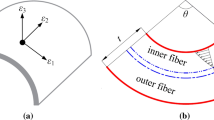Abstract
Accurate characterization of the fracture limit in plane strain tension of automotive sheet metals is critical for the design and crash performance of structural components. Plane strain bending using the VDA 238–100 V-bend test has potential for proportional fracture characterization by avoiding a tensile instability. The VDA 238–100 V-bend test was evaluated using DIC strain measurement to characterize the plane strain fracture limit under proportional plane stress loading and to evaluate the effect of the VDA pre-straining methodology for ductile alloys upon the material response. The load-based failure criterion of the V-bend test was evaluated with DIC to monitor the development of surface cracking. The influence of the non-linear strain path imposed by the pre-straining procedure for ductile materials was then evaluated for three automotive alloys: an advanced high strength dual phase steel, DP1180, a rare-earth magnesium, ZEK100, and an AA5182 aluminum. A fracture criterion based on the load threshold was reasonable for the three alloys considered. Pre-straining in uniaxial tension prior to plane strain bending affected each alloy differently. The DP1180 was not affected by the non-linear strain path whereas the cumulative equivalent strain for the AA5182 and ZEK100 increased by strains of 0.07 and 0.05 strain, respectively. The non-linear strain path within the VDA pre-straining methodology creates ambiguity in comparing the fracture limits of different materials. The plane strain fracture limit for proportional loading can be readily obtained in the V-bend test with DIC strain measurement.

















Similar content being viewed by others
References
VDA 238–100, (2010). Test Specification: Plate Bending Test for Metallic Materials
VDA 238–100, (2017). Test Specification: Plate Bending Test for Metallic Materials
Omer K, Ten Kortenaar L, Butcher C, Worswick M, Malcolm S, Detwiler D (2017) Testing of a hot stamped axial crush member with tailored properties – experiments and models. International Journal of Impact Engineering 103:12–28
Cheong K, Omer K, Butcher C, George R, Dykeman J (2017) Evaluation of the VDA 238–100 tight radius bending test using digital image correlation strain measurements, IOP Conference Series: Journal of Physics
Roth CC, Mohr D (2016) Ductile fracture experiments with locally proportional loading histories. Internatioal Journal of Plasticity 79:328–354
Bai Y, Wierzbicki T (2010) Application of extended Mohr-coulomb criterion to ductile fracture. Int J Fract 161:1–20
Dunand M, Mohr D (2010) Hybrid experimental-numerical analysis of basic ductile fracture experiments for sheet metals. International Journa of Solids and Structures 47:1130–1143
Pack K, Ahn K, Huh H, Lou Y (2014) Fracture modelling of DP780 sheets using a hybrid experimental-numerical method and two-dimensional digital image correlation, international journal of materials and product technology, 48
Mohr D, Henn S (2007) Calibration of stress-triaxiality dependent crack formation criteria: a new hybrid experimental-numerical method. Journal of Experimental Mechanics 47:805–820
Grolleau V, Roth CC, Lafile V, Galpin B, Mohr D (2019) Loading of mini-Nakazima specimens with a dihedral punch: Determinating the strain to fracture for plane strain tension through stretch-bending. Int J Mech Sci 152:329–345
Cheong K, Butcher C, Dykeman J (2018) The influence of the through-thickness strain gradients on the fracture characterization of advanced high-strength steels, SAE international journal of materials and manufacturing, SAE technical paper 2018-01-0627
Gorji M, Berisha B, Hora P, Barlat F (2016) Modeling of localization and fracture phenomena in strain and stress space for sheet metal forming. Int J Mater Form 9:573–584
Abedini A, Butcher C, Worswick MJ (2018) Experimental fracture characterization of an anisotropic magnesium alloy sheet in proportional and non-proportional loading conditions. Int J Solids Struct 144-145:1–19
Abbadi M, Haehner P, Zeghloul A (2002) On the characteristics of Portevin-Le Chatelier bands in aluminum alloy 5182 under stress-controlled and strain-controlled tensile testing. Mater Sci Eng A337:194–201
Van den Boogard AH, van Riel M, Huetink J (2005) Evaluation of stresses in a combined plane strain-simple shear test, ESAFORM Conference on Material Forming
Goncalves J, Jotz G, Huet F (2018) Stakes and solutions for in-plane sheet metal formability assessment. IOP Conference Series: Material Science and Engineering 418:012053
Ha J, Baral M, Korkolis YP (2018) Plastic anisotropy and ductile fracture of bake-hardened AA6013 aluminum sheet. Int J Solids Struct 155:123–139
Hill R (1950) The mathematical theory of plasticity, Oxford Press
Woelke PB, Londono JG, Knoerr LO, Dykeman J, Malcolm S (2018) Fundamental differences between fracture behavior of thin sheets under plane strain bending and tension, IOP Conference Series: Materials Science and Engineering, 418
Cheong K (2018) On the influence of the through-thickness strain gradients for characterization of formability and fracture of sheet metal alloys, Master Thesis, Univeristy of Waterloo
Larour P, Hackl B, Leomann F (2013) Sensitivity analysis on the calculated bending angle in the instrumented bending test, IDDRG 2013 conference proceedings
Johnson GR, Cook WH (1985) Fracture characteristics of three metals subjected to various strains, strain rates, temperatures and pressures. Eng Fract Mech 21(1):31–48
Acknowledgements
The authors would like to thank the members of the Nonlinear Strain Path Project Team of the A/SP and Kenneth Cheong of the University of Waterloo, for valuable discussions on failure characterization in the Tight Radius Bend Test.
Funding
Financial support for this study was provided in part by the Natural Sciences and Engineering Research Council of Canada and the Auto/Steel Partnership (A/SP) who provided the DP1180 steel.
Author information
Authors and Affiliations
Corresponding author
Ethics declarations
Conflict of Interest
The authors declare that they have no conflict of interest.
Additional information
Publisher’s Note
Springer Nature remains neutral with regard to jurisdictional claims in published maps and institutional affiliations.
Rights and permissions
About this article
Cite this article
Noder, J., Abedini, A. & Butcher, C. Evaluation of the VDA 238–100 Tight Radius Bend Test for Plane Strain Fracture Characterization of Automotive Sheet Metals. Exp Mech 60, 787–800 (2020). https://doi.org/10.1007/s11340-020-00597-2
Received:
Accepted:
Published:
Issue Date:
DOI: https://doi.org/10.1007/s11340-020-00597-2




